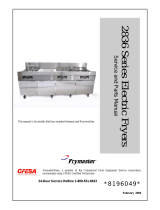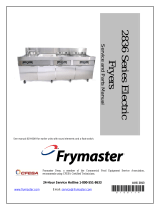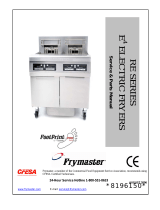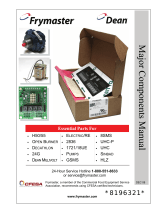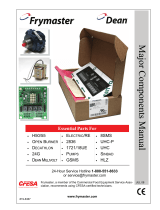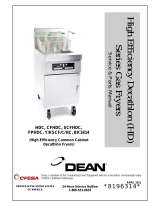
Frymaster Dean, a member of the Commercial Food Equipment Service Association,
recommends using CFESA Certified Technicians.
24-Hour Service Hotline 1-800-551-8633
MAY 2006
www.frymaster.com Email: [email protected]
*8196114*
This manual is for fryers starting with series AD manufactured starting Fall
2006. This manual makes no references to previous models with rounded
elements and float switches. For parts associated with those fryers, refer to 2836
Series Service and Parts Manual part number 819-6049.
2836 Series Electric Fryers
Service and Parts Manual

NOTICE
IF, DURING THE WARRANTY PERIOD, THE CUSTOMER USES A PART FOR THIS ENODIS
EQUIPMENT OTHER THAN AN UNMODIFIED NEW OR RECYCLED PART PURCHASED DIRECTLY
FROM FRYMASTER DEAN, OR ANY OF ITS AUTHORIZED SERVICE CENTERS, AND/OR THE PART
BEING USED IS MODIFIED FROM ITS ORIGINAL CONFIGURATION, THIS WARRANTY WILL BE VOID.
FURTHER, FRYMASTER DEAN AND ITS AFFILIATES WILL NOT BE LIABLE FOR ANY CLAIMS,
DAMAGES OR EXPENSES INCURRED BY THE CUSTOMER WHICH ARISE DIRECTLY OR
INDIRECTLY, IN WHOLE OR IN PART, DUE TO THE INSTALLATION OF ANY MODIFIED PART
AND/OR PART RECEIVED FROM AN UNAUTHORIZED SERVICE CENTER.
NOTICE
This appliance is intended for professional use only and is to be operated by qualified personnel
only. A Frymaster Dean Factory Authorized Service Center (FASC) or other qualified professional
should perform installation, maintenance, and repairs. Installation, maintenance, or repairs by
unqualified personnel may void the manufacturer’s warranty. See Chapter 1 of this manual for
definitions of qualified personnel.
NOTICE
This equipment must be installed in accordance with the appropriate national and local codes of the
country and/or region in which the appliance is installed.
NOTICE
Drawings and photos used in this manual are intended to illustrate operational, cleaning and
technical procedures and may not conform to onsite management operational procedures.
NOTICE TO OWNERS OF UNITS EQUIPPED WITH COMPUTERS
U.S.
This device complies with Part 15 of the FCC rules. Operation is subject to the following two
conditions: 1) This device may not cause harmful interference, and 2) This device must accept any
interference received, including interference that may cause undesired operation. While this device
is a verified Class A device, it has been shown to meet Class B limits.
CANADA
This digital apparatus does not exceed the Class A or B limits for radio noise emissions as set out
by the ICES-003 standard of the Canadian Department of Communications.
Cet appareil numerique n’emet pas de bruits radioelectriques depassany les limites de classe A et B
prescrites dans la norme NMB-003 edictee par le Ministre des Communications du Canada.
DANGER
Improper installation, adjustment, maintenance or service, and unauthorized alterations or
modifications can cause property damage, injury, or death. Read the installation, operating and
service instructions thoroughly before installing or servicing this equipment.
DANGER
Copper wire suitable for at least 167ºF (75ºC) must be used for power connections.
DANGER
The electrical power supply for this appliance must be the same as indicated on the rating and serial
number plate located on the inside of the fryer door.

DANGER
This appliance must be connected to the voltage and phase as specified on the ratings and serial
number plate located on the inside of the fryer door.
WARNING
Do not attach accessories to this fryer unless the fryer is secured from tipping. Personal injury may
result.
WARNING
Do not use water jets to clean this equipment.
WARNING
This equipment is intended for indoor use only. Do not install or operated this equipment in outdoor
areas.
DANGER
Adequate means must be provided to limit the movement of this appliance without depending on or
transmitting stress to the electrical conduit. A restraint kit is provided with the fryer. If the restraint
kit is missing contact your local Frymaster Dean Factory Authorized Service Center (FASC) for part
number 826-0900.
DANGER
Prior to movement, testing, maintenance and any repair on your Frymaster fryer, disconnect all
electrical power from the fryer.
DANGER
The front ledge of the fryer is not a step. Do not stand on the fryer. Serious injury can result from
slips or contact with the hot oil.
DANGER
Do not store or use gasoline or other flammable vapors and liquids in the vicinity of this or any other
appliance.
DANGER
The crumb tray in fryers equipped with a filter system must be emptied into a fireproof container at
the end of frying operations each day. Some food particles can spontaneously combust if left
soaking in certain shortening material. Additional information can be obtained in the filtration
manual included with the system.
WARNING
No structural material on the fryer should be altered or removed to accommodate placement of the
fryer under a hood. Questions? Call the Frymaster Dean Service Hotline at 1-800-551-8633.
WARNING
Do not bang fry baskets or other utensils on the fryer’s joiner strip. The strip is present to seal the
joint between the frypot. Banging fry baskets on the strip to dislodge shortening will distort the
strip, adversely affecting its fit. It is designed for a tight fit and should only be removed for cleaning.

2836 Series Electric Fryers
Service & Parts Manual
TABLE OF CONTENTS
Page #
1. SERVICE PROCEDURES 1-1
1.1 General 1-1
1.2 Replace Computer/Controller 1-1
1.3 Replace Interface Board 1-2
1.4 Replace Transformer 1-3
1.5 Replace Temperature Probe 1-3
1.6 Replace Heating Element 1-4
1.7 Replace High-Limit 1-6
1.8 Replace Frypot 1-6
1.9 Replace Contactor (Latching or Heating) 1-7
1.10 Built-in Filter System Service Procedures 1-7
1.11 Basket Lift Service Procedures 1-9
1.12 Electric Interface Board Diagnostic Chart 1-12
1.13 Probe Resistance Chart 1-13
1.14.1 Wiring Diagrams, Main 208/240V 1-14
1.14.2 Wiring Diagrams, Main 480V (120V Controls) 1-15
1.14.3 Wiring Diagrams, Main FP28DV/36 480V (120V Controls) 1-16
1.15 Wiring Diagrams, Modular Basket Lifts 1-17
1.16 Wiring Diagrams, 208/240V Systems With Built-in Filtration 1-18
1.16.1 Wiring Diagrams, 480V Systems With Built-in Filtration 1-19

2836 Series Electric Fryers
Service & Parts Manual
TABLE OF CONTENTS (CONT.)
Page #
2. PARTS LIST 2-1
2.1 Accessories 2-1
2.2 Basket Lift Assembly (Modular) and Related Components 2-2
2.3 Cabinetry and Related Components 2-5
2.3.1.1 F228 Cabinetry 2-5
2.3.1.2 F128/136 Cabinetry 2-7
2.3.1.3 F128/236 Cabinetry 2-9
2.3.2 Door Components 2-11
2.3.3 Dump Station Components 2-12
2.4 Computer and Related Components 2-13
2.5 Contactor and Power Cord Box Assembly 2-14
2.6 Terminal Block Mount Assembly 2-16
2.7 Component Box Assembly 2-17
2.8 Filter Pan and Related Components 2-19
2.9 Frypot and Related Components 2-20
2.9.1.1 Frypot and Drain Valve Components 2-20
2.9.1.2 Drain Components 2-21
2.10 Elements and Related Components 2-22
2.11 Oil Disposal Wand 2-24
2.12 Oil Return Assembly 2-25
2.13 Filter Pump Assembly 2-27
2.14 Wiring Harnesses and Cables 2-28

2836 SERIES ELECTRIC FRYERS
CHAPTER 1: SERVICE PROCEDURES
1-1
FINDING YOUR WAY AROUND THE 2836 SERIES FRYER
Left
Contactor
Box
Right
Contactor
Box
Under Fryer
Filtration
Filter
Control
Handles
Left Drain
Handle
Right Drain
Handle
Interface
Board
Wire
Harness
Controller
Transformers
Fuse
Terminal
Block
Mercury
Contactor
Mechanical
Contactor
Contactor Box
Component
Box

1-2
1.1 General
Before performing any maintenance on your Frymaster Dean 2836 Series Electric fryer, you must
disconnect the electrical power supply.
When electrical wires are disconnected, it is recommended that they be marked in such a way as to
facilitate reassembly.
DANGER
Hot oil will cause severe burns. Never attempt to move this appliance when filled with hot
oil, or to transfer hot oil from one container to another.
DANGER
This equipment should be unplugged when servicing, except when electrical circuit tests are
required. Use extreme care when performing such tests.
This appliance may have more than one electrical power supply connection point.
Disconnect all power cords before servicing.
Inspection, testing and repair of electrical components should be performed by an
authorized service agent only.
1.2 Replace Computer/Controller
1. Unscrew and remove two control panel screws on control panel front. Swing the panel open
from the top.
2. Unplug wiring harness at plug on back of controller. Unplug controller ground wire from
controller.
3. Remove the control panel/controller by lifting the assembly from the hinged slots in the control-
panel frame.
4. Reverse procedures to install new controller.
1.3 Replace Interface Board
1. Unplug all power cords. Perform Procedure 1.2, Steps 1-4, Replace Computer/Controller.
2. Unplug wire harness from the interface board. Remove all wiring from the terminals of the
interface board, ensuring that each wire is marked for reattachment.
3. Remove the nuts from each corner of the interface board and slide the board from the studs.
Unplug connectors J1 and J2, mark and unplug all other wiring on rear of the interface board.
Ensure that standoffs remain in place on studs prior to installing new interface board. Install the
new interface board by reversing the previous procedures.

1-3
4. Ensure that wire harnesses are connected to back of interface board prior to securing interface
board. Also, ensure that wiring and wire harnesses are connected to the proper terminals.
1.4 Replace Transformer
1. Unplug all power cords. Perform Procedure 1.2, Steps 1-4, Replace Computer/Controller.
2. Hold new transformer up to old transformer to be replaced and disconnect one wire at a time
from old and connect to new.
3. Remove the screws that secure the transformer to the component box.
4. Install the new transformer by reversing the preceding procedures. Make sure you reconnect the
wiring to the proper terminals and the harnesses to the correct connectors.
1.5 Replace Temperature Probe
1. Unplug fryer from the electrical source.
2. Drain the cooking oil from the frypot.
3. Remove the fryer from the exhaust hood to gain access to the rear of the fryer.
4. If unit is equipped with modular basket lift, remove basket lift assembly and set aside.
5. Remove the screws from the top cap and back cover(s). Set the cover(s), top cap and screws
aside.
6. Disconnect the wire harness containing the probe wiring. It may be necessary to remove the
wire ties.
7. Use a pin-pusher (P/N 806-4855 or P/N 807-
0928) to remove the red and white probe
wires from the connector. Note probe pin
location in plug. Pull the probe wires out of
the insulation.
8. Remove the screw(s) securing the probe
bracket to the element. Remove the metal
wraps securing the probe to the element.
Use a pin-pusher to remove probe wires from
connector (arrows).

1-4
9. Remove the probe bracket and the securing components from the probe bulb and element.
Thread the probe wire through the hole in the tilt plate assembly and remove the probe.
10. Thread the new probe wire through the hole in tilt plate. Place the new temperature probe
assembly onto the element and secure with the bracket and screws removed earlier. Clip the
probe onto the rear of the element in two places. The temperature probe assembly should be
oriented in the same manner as the probe being replaced.
11. Thread the probe wires into the harness insulation. Note the pin positions and insert pins in the
connector. Reconnect the harness and secure with a wire-tie.
12. Lower the element into the frypot with the lift handle.
13. Install the back covers, basket lift assembly, and top cap and secure with screws.
1.6 Replace Heating Element
1. Perform Procedure 1.5, Replace Temperature Probe, Steps 1-7.
2. Unplug the element connectors for the
element being removed (right element- 6-pin
harness connector; left element- 9-pin harness
connector). Remove the element wires from
the connector. Press down on either side of
the connector while pulling up on the top
portion. The connector will open from the
top. Note wiring configuration in connector
before removing element wire pins. Pull all
wires from the connector.
3. Loosen conduit connector and pull element
wires through conduit.
4. Remove the screws securing the temperature
probe bracket from the element. Remove the
probe clamp (metal wire-wrap). Set the
temperature probe and probe-securing
components aside.
NOTE: Temperature probe removal is not
required if the left element is being replaced.
Top Portion
Harness
Connector
Closed
Harness
Connector
Open
Push in on tabs to release
top portion
5. Disconnect the element springs from the tilt brackets.
6. Remove the element clamps and hardware before removing mounting-screws and nuts on the
defective element. Remove all wire-ties securing element wiring, and then remove element from
frypot.
Loosen connector here.

1-5
7. Install the replacement element in the frypot and secure with the mounting hardware.
8. Reinstall the temperature probe and probe-bracket components onto the replacement element.
9. Route the element leads (terminals) to the rear of the fryer
10. Secure element wiring with wire-ties.
11. Route the element wires through the conduit
and tighten conduit connector.
11. When replacing the left element (as viewed
from the rear of the fryer), use the 9-pin
connector, inserting the leads from the
replacement element. Ensure the pin
numbers match the numbers of the defective
element wires. When all pin terminals have
been fully inserted, close the connector by
sliding the halves together until the tabs snap
back into place (reverse procedure in this
section, Step 2). Check wire numbers to
ensure correct wiring of the replacement
element.
When replacing the right element (as viewed
from the rear of the fryer), follow the above
procedure, inserting pin terminals into the
corresponding holes in the 6-pin connector.
12. Connect the connectors, ensuring the latches
lock in place.
13. Install the temperature probe wires (marked for re-assembly) in the corresponding pin locations.
14. Reconnect the element springs to the tilt brackets
15. Install the back covers, basket lift assembly, and top cap and secure with screws.
16. Position fryer under exhaust hood.
Left Element—
9-Pin Connector
Right Element—
6-Pin Connector
Ensure that the wires are properly routed and
secured.

1-6
1.7 Replace High-Limit
1. Perform Procedure 1.5, Replace Temperature
Probe, Steps 1-4.
2. Disconnect the wire harness containing the
high-limit wires.
3. Use a pin-pusher (P/N 806-4855 or P/N 807-
0928) to remove the two high-limit wires
from the wire harness connector (arrows).
Note pin location in connector before
removing wires.
4. Remove the high-limit from the frypot using
an open-end wrench or other suitable tool.
5. Apply Loc-Tite PST 567 sealant to the
replacement high-limit threads.
6. Screw the replacement high-limit into the
frypot and tighten to 170-180 inch-pounds
torque. DO NOT OVERTIGHTEN.
7. Insert the replacement high-limit wires into
the connector, ensuring each wire is in the
correct hole..
8. Reconnect the high-limit wire-harness
connector.
9. Install and secure the back cover(s).
10. Return fryer to operation.
1.8 Replace Frypot
1. Perform Procedure 1.5, Replace Temperature Probe, Steps 1-7.
2. Perform Procedure 1.2, Replace Computer/Controller, Steps 1-3.
3. Perform Procedure 1.7, Replace High-Limit, Steps 1-4.
4. Disconnect the element wire harnesses.
5. If the fryer has a built-in filtration system, remove all the plumbing from the frypot, including
oil-return and drain plumbing.
Place wrench here when removing and installing
high-limit.
Using a pin-pusher, remove two high-limit wires
(arrows) from connector.

1-7
6. Remove the screws securing the frypot to the front frame of the fryer.
7. Carefully lift the frypot from the cabinet.
8. Remove the drain valve from the old frypot and install on the new frypot.
9. Apply Loc-Tite Sealant PST 567 to the high-limit threads. Install high-limit into the new frypot.
10. Disconnect the tilt plate springs from the old frypot.
11. Remove the securing screws from the tilt plate. Lift the tilt plate/heating element assembly from
the old frypot and install on the new frypot.
12. Follow the preceding steps in reverse to install the new frypot into the fryer.
13. NOTE: Apply Loc-Tite Sealant PST 567 to all pipefittings prior to installation.
1.9 Replace Contactor (Latching or Heating)
1. Remove filter pan.
2. Remove cover to contactor box.
3. Identify faulty contactor. Remove all wiring connected to the contactor terminals inside the
component box. Tape wire-pairs together and mark each wire-set or wire for reassembly.
4. Remove contactor-mounting screws and remove the contactor.
5. Install the new contactor and connect the wiring removed in Step 3.
1.10 Built-in Filter System Service Procedures
Troubleshooting Built-In Filtration Systems
One of the most common errors is placing the filter paper on the bottom of the filter pan rather than
over the filter screen.
CAUTION
Ensure that the paper support screen is in place prior to filter paper placement and
filter pump operation. Improper screen placement is the major cause of filter system
malfunction.
Whenever the complaint is "the pump is running, but no oil is being filtered", check the installation
of the filter paper, and ensure that the correct size is being used.

1-8
If the pump motor overheats, a circuit breaker will trip and the motor will not start until the breaker
is reset. If the pump motor does not start, press the white reset button located under the component
box, inside the cabinet.
If the pump starts after resetting the breaker, then something is causing the motor to overheat. A
major cause of overheating is when several frypots are filtered sequentially, thus overheating the
pump and motor. Allow the pump motor to cool at least 30 minutes before resuming operation, and
allow time for the motor to cool between sequential frypot filtering.
Pump overheating can be caused by:
• Solidified shortening in the pan or filter lines,
or
• Attempting to filter unheated oil or shortening.
Cold oil and shortening are more viscous, causing the pump motor to overheat. Always filter with
the oil or shortening at operating temperature [350°F (177°C)].
If the motor runs but the pump does not,
there is a blockage in the pump. Incorrectly
sized or installed paper/pads will allow food
particles and sediment to pass through the
filter pan and into the pump. When sediment
enters the pump, the gears bind, causing the
motor to overload, again tripping the thermal
overload. Solidified shortening in the pump
will also cause it to seize, with the same
problem.
A pump seized by debris or hard shortening
can usually be freed by manually moving the
gears with a screwdriver or other instrument.
Disconnect power to the filter system,
remove the input plumbing from the pump,
and use a screwdriver to manually turn the
gears.
● Turning the pump gears in reverse will
release a hard particle.
● Turning the pump gears forward will push softer objects and solid shortening through the
pump and allow free movement of the gears.
Incorrectly sized or installed paper/pads allows food particles and sediment to pass through and clog
the suction tube on the bottom of the filter pan. Particles large enough to block the suction tube may
indicate that the crumb tray is not being used. Pan blockage can also occur if shortening is left in the
pan and allowed to solidify. Blockage removal can be accomplished by forcing the item out with an
Sediment Particle
Oil Flow
Up for reverse
Down for forward
Sediment Particle

1-9
auger or drain snake. Compressed air or other pressurized gases should not be used to force out the
blockage
1.11 Basket Lift Service Procedures
2836 Series Electric fryers may optionally be equipped with automatic basket lifts to ensure uniform
cooking times. Electric fryers can be equipped with "modular" or "bell-crank" basket lifts.
A modular basket lift (illustrated) consists
of a toothed rod to which the basket lift arm
is attached, a reversible-drive gear motor
and a pair of roller-activated microswitches.
The gear motor engages the teeth of the
rods, moving them up or down, depending
upon the motors’ direction. The
microswitches at the upper and lower limits
of movement stop the motor when the
basket is in the full up or full down position.
Timing circuitry in the controller initiates
and stops basket lift operation depending
upon the variables programmed by the
operator. When the product button is
pressed, the timing circuitry activates a coil
in the basket lift relay to supply power to the
lower microswitch. The microswitches stop
the motor at the lift’s upper and lower travel
limits and reverse the direction of current
flow, thus reversing the motor direction.
Modular Basket Lift Assembly (Typical).

1-10
Simplified Schematic
M
H
N
Normally Closed Lower-limit
Microswitch
6
To computer/controller via
interface board
Basket Lift
Relay
3
1 or 4
5
Normally Open Upper-limit
Microswitch
When the product button is pushed on the computer/controller, current flows through a coil in the
basket lift relay, causing the lower circuit to be activated. The basket lift lowers, closing the
normally open upper-microswitch. When the lower normally closed microswitch is opened by the
downward moving lift rod, power to the motor ceases to flow. When the computer/controller times-
out, the current to the relay coil is interrupted, allowing the upper circuit to be activated. The basket
lift then raises and closes the lower microswitch. When the basket lift rod clears the upper
microswitch, the microswitch opens, and power to the circuit is interrupted, stopping the motor.
Pushing the product button or activating the manual control (if equipped) restarts the cycle.
Problems with the modular basket lift design can be grouped into three categories:
● Binding/jamming problems
● Motor and gear problems
● Electronics problems

1-11
BINDING/JAMMING PROBLEMS
Noisy, jerky or erratic movement of the lifts is usually due to lack of lubrication of the rods and their
bushings. Apply a light coat of Lubriplate
or similar lightweight white grease to the rod and
bushings to correct the problem.
With the modular basket lift, another possible cause of binding is improper positioning of the motor,
which prevents the gear from correctly engaging the teeth in the rod. To correct the problem, loosen
the screws that hold the motor in place and move it forward or backward until the rod has just
enough slack to be rotated slightly.
MOTOR AND GEAR PROBLEMS
With the modular basket lift, the most likely problem to be encountered in this category is erratic
motion of the lift due to a worn drive gear. Failure to keep the lift rod and bushings properly
lubricated will cause unnecessary wear of the gear. The problem is corrected by replacing the worn
gear.
If the lift cycles correctly but fails to remain in the up position (i.e., goes up, but then slowly settles
back down into the frypot), the problem is a failed motor brake. The motor must be replaced.
If power is reaching the motor but the motor fails to run, the motor is burned out and must be
replaced.
ELECTRONICS PROBLEMS
Within this category are problems associated with the relays, microswitches, capacitors, resistors,
interface board, wiring, and controls. The most common problem in this category is a lift that
continuously travels up and down. This is usually caused by a microswitch that is out of adjustment.
Troubleshooting the electronics of a modular-type basket lift is simply a process of verifying current
flow through the individual components up to and including the motor. Using a multimeter set to the
250 VAC range, check the connections on both sides of the component for the presence of the
applied line voltage. The accompanying simplified wiring diagrams identify the components and
wiring connection points.

1-12
1.12 Electric Interface Board Diagnostic Chart
The following diagram and charts provide ten quick system checks that can be performed using
only a multimeter.
Meter Setting Test Pin Pin Results
12 VAC Power 50 VAC Scale 1 of J2 3 of J2 12-16 VAC
24 VAC Power 50 VAC Scale 2 of J2 Chassis 24-30 VAC
*Probe Resistance R X 1000 OHMS 11 of J2 12 of J2 See Chart
Hi-Limit Continuity R X 1 OHMS 7 of J2 4 of J2 0 - OHMS
Latch Contactor Coil R X 1 OHMS 8 of J2 Chassis 3-10 OHMS
Heat Contactor Coil R X 1 OHMS 9 of J2 Chassis 18-25 OHMS
*Disconnect 15-Pin harness from the computer/controller before testing the probe circuit.
Note: The sealed relays are
replaceable. If a relay fails,
the replacement part number
is 807-3932.
Diagnostic LED Legend
CMP indicates power from 12V transformer
24 indicates power from 24V transformer
HI (RH) indicates output (closed) from right latch
relay
HI (LH) not applicable to Ultimate Electric fryers
HT (RH) indicates output from right heat relay
HT (LH) not applicable to Ultimate Electric fryers
AL (RH) indicates output (open) from right latch
relay
AL (LH) not applicable to Ultimate Electric fryers
1
23
4
5
6
8
7
9
10
11
12
13
14
15
1
2
3
4
5
6
7
8
9
10
11
12
1
2
3
4
5
6
7
8
9
10
11
12
K1
K2
K3 K4

1-13
1.13 Probe Resistance Chart
Use the chart below when testing temperature probes and probe circuits for proper operation.
Probe Resistance Chart
F OHMS C F OHMS C F OHMS C F OHMS C F OHMS C
60 1059 16 130 1204 54 200 1350 93 270 1493 132 340 1634 171
65 1070 18 135 1216 57 205 1361 96 275 1503 135 345 1644 174
70 1080 21 140 1226 60 210 1371 99 280 1514 138 350 1654 177
75 1091 24 145 1237 63 215 1381 102 285 1524 141 355 1664 179
80 1101 27 150 1247 66 220 1391 104 290 1534 143 360 1674 182
85 1112 29 155 1258 68 225 1402 107 295 1544 146 365 1684 185
90 1122 32 160 1268 71 230 1412 110 300 1554 149 370 1694 188
95 1133 35 165 1278 74 235 1422 113 305 1564 152 375 1704 191
100 1143 38 170 1289 77 240 1432 116 310 1574 154 380 1714 193
105 1154 41 175 1299 79 245 1442 118 315 1584 157 385 1724 196
110 1164 43 180 1309 82 250 1453 121 320 1594 160 390 1734 199
115 1174 46 185 1320 85 255 1463 124 325 1604 163 395 1744 202
120 1185 49 190 1330 88 260 1473 127 330 1614 166 400 1754 204
125 1195 52 195 1340 91 265 1483 129 335 1624 168 405 1764 207

1-14
1.14.1 Wiring Diagrams, Main – 208/240V

1-15
1.14.2 Wiring Diagrams, Main 480V (120 V Controls)
Page is loading ...
Page is loading ...
Page is loading ...
Page is loading ...
Page is loading ...
Page is loading ...
Page is loading ...
Page is loading ...
Page is loading ...
Page is loading ...
Page is loading ...
Page is loading ...
Page is loading ...
Page is loading ...
Page is loading ...
Page is loading ...
Page is loading ...
Page is loading ...
Page is loading ...
Page is loading ...
Page is loading ...
Page is loading ...
Page is loading ...
Page is loading ...
Page is loading ...
Page is loading ...
Page is loading ...
Page is loading ...
Page is loading ...
Page is loading ...
Page is loading ...
Page is loading ...
Page is loading ...
Page is loading ...
/
